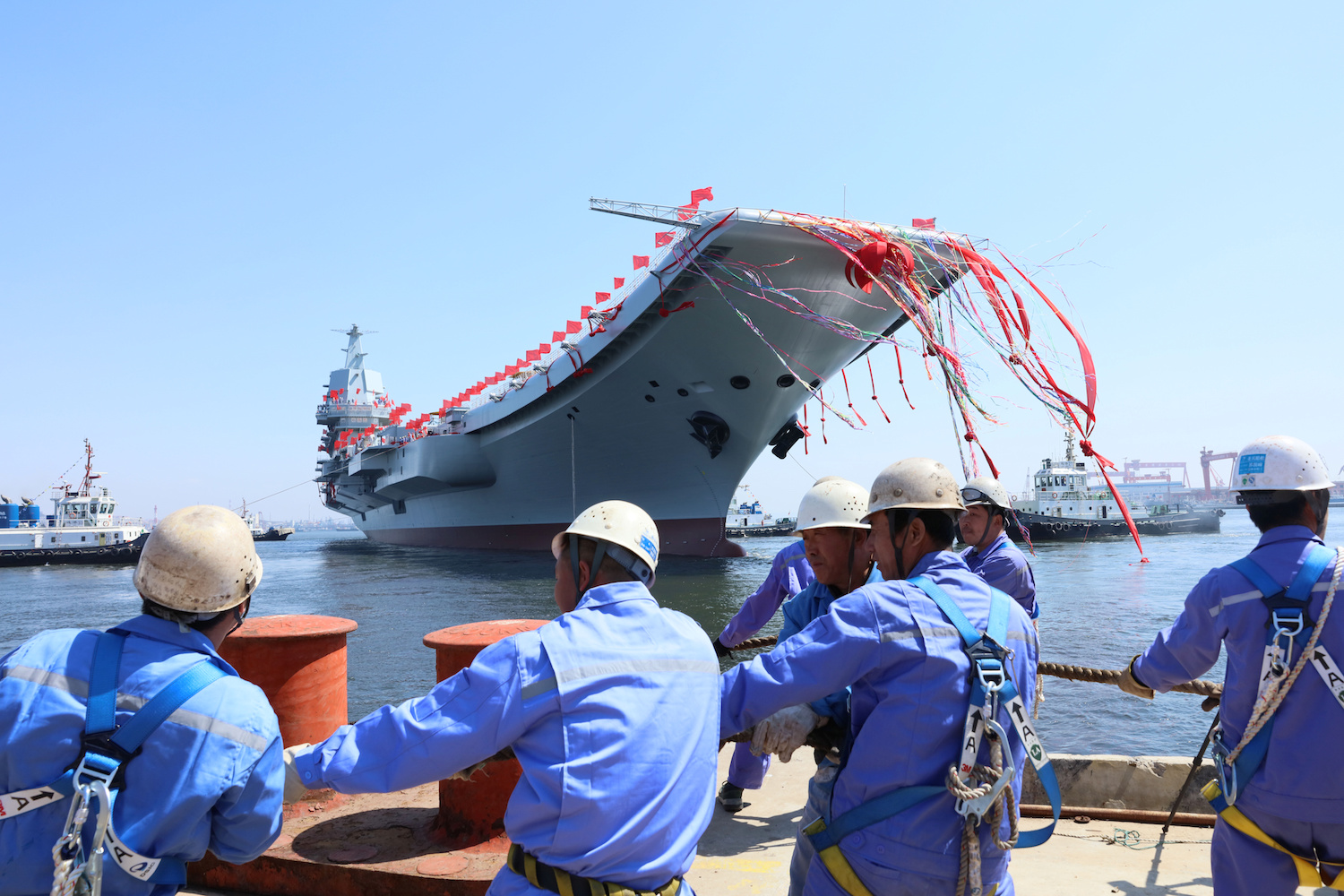China cracked a bottle of Champagne on the hull of its second aircraft carrier Wednesday as it took to the seas for the first time. China built the carrier as part of a massive push to modernize its navy and imitate the power-projection capabilities of the US Navy.
While the new, unnamed carrier looks like the country’s original, Soviet-made Liaoning carrier, China has incorporated lessons learned from the older vessel into its new ship. With a larger hangar and improved technology, the new carrier, which has been in production since 2013, should become operational in 2020.
China’s recent naval modernization has raised eyebrows in the Pacific and globally, as China ignores international law, builds and militarizes artificial islands in the South China Sea, and threatens and bullies its neighbors.
See how China’s aircraft carriers stack up to other carriers worldwide:
So far, little is known of China's new carrier, which is only known as the Type 001A. It will take years of sea trials and practice to develop it into a fully functioning carrier. As it stands, there are likely US Navy pilots with about as many carrier landings and takeoffs as the entire Chinese navy.

The carrier will field an enhanced S-band radar and a reconfigured island, or the tower on top of the main deck. The new deck will allow the Type 001A to accommodate more aircraft, asUSNI News reports.
This is China's only operational aircraft carrier, the Liaoning. Like much of China's military hardware, the Liaoning is a reworking of an older Russian-made model.

The Soviet style of carrier, which Russia and China still use, has a different purpose than the US's flat top carriers. Instead of being a truly global strike carrier, these carriers make more sense for coastal defense.
The Liaoning's particulars and capabilities sound impressive.

Source: Jeff Head
Over the last four years, China's People's Liberation Army Navy has had to build up carrier operations from nothing. It has never operated an aircraft carrier, so it faced a steep learning curve.

The Liaoning launches planes off a "ski jump"-style deck because it lacks the catapults that US carriers have.

This means that the J-15 Flying Shark aircraft that take off from the Liaoning or the Type 001A can't carry as much fuel or as many bombs as the US's carrier based planes can. This greatly limits their range and effectiveness in combat.
But while the planes must travel light, the Liaoning and Type 001A boast a heavy arsenals of their own.

The Admiral Kuznetsov, which the Liaoning, and to some degree the Type 001A are based on, was Russia's sole aircraft carrier. The ships have the same size and speed, and they both feature the "ski jump" platform.

The Kuznetsov, which carried out its first combat deployment in the Mediterranean bolstering the Syrian regime in 2016, has a troubled past plagued with mechanical difficulties. Everywhere it sails, a tugboat accompanies it in case it breaks down, as was the case in 2012.

China's southern neighbor, India, operates two smaller aircraft carriers with a third in production, but they are more reliable. In 2014, the Liaoning experienced unexpected power failures while at sea.

For the past few years, the Liaoning has been designated a training vessel.
Source: Business Insider
China's eastern neighbor, Japan, has smaller "helicopter destroyers," or flat deck carriers that sport helicopters and short- or vertical-takeoff aircraft as well as heavy armaments and missiles.

Source: Business Insider
But Japan has a trick up its sleeve. It recently launched a larger class of helicopter carrier, the Izumo class. Soon, these carriers will support the F-35B marine variant, which experts expect will provide unprecedented dominance in air and sea.

Source: Jeff Head
But the US is the world's undisputed king of carriers. The USS Abraham Lincoln, one of the US Navy's 10 Nimitz-class aircraft carriers, is larger and carries more planes than the Liaoning or the Type 001A, and it features catapults to launch heavier planes.

US carriers boast nuclear-powered cores, so they can sail around the globe without being refueled or relying on tankers.
But China reportedly does have plans to build a US-style carrier with catapults, which could enable it be more competitive with US carriers.

Source: USNI News
Pound for pound, US carriers don't carry as many weapons as their foreign counterparts, but they travel in strike groups, which include guided missile destroyers to defend them.

(Not pictured: submarines.)
Furthermore, the US is developing an even larger, more advanced class of aircraft carrier with an outsized power core to support weapons of the future, like railguns and lasers.

Here's more information on the Ford-class carriers »
Also, US carriers use a whole team of aircraft. Transport planes handle logistics; electronic warfare squadrons back up fighters; airborne warning and control planes — AWACS, like the E-2 Hawkeye below — transmit huge amounts of targeting data from the sky; helicopters hunt submarines and move personnel.

Read more about US carrier operations and aircraft »
To put things in perspective, this graphic shows the relative sizes of aircraft carriers from around the world.

And let's not forget that the US has more aircraft carriers than the rest of the world combined.


